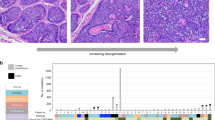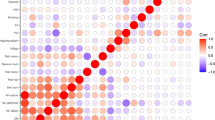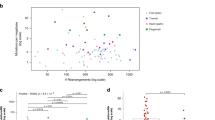Abstract
Familial cylindromatosis is an autosomal dominant genetic predisposition to multiple tumours of the skin appendages. The susceptibility gene (CYLD) has previously been localized to chromosome 16q and has the genetic attributes of a tumour-suppressor gene (recessive oncogene). Here we have identified CYLD by detecting germline mutations in 21 cylindromatosis families and somatic mutations in 1 sporadic and 5 familial cylindromas. All mutations predict truncation or absence of the encoded protein. CYLD encodes three cytoskeletal-associated-protein–glycine-conserved (CAP–GLY) domains, which are found in proteins that coordinate the attachment of organelles to microtubules. CYLD also has sequence homology to the catalytic domain of ubiquitin carboxy-terminal hydrolases (UCH).
This is a preview of subscription content, access via your institution
Access options
Subscribe to this journal
Receive 12 print issues and online access
$209.00 per year
only $17.42 per issue
Buy this article
- Purchase on Springer Link
- Instant access to full article PDF
Prices may be subject to local taxes which are calculated during checkout





Similar content being viewed by others
Accession codes
References
Abenoza, P. & Ackerman, A.B. Neoplasms with Eccrine Differentiation (Lea and Febiger, Philadelphia, 1990).
van Balkom, I.D. & Hennekam, R.C. Dermal eccrine cylindromatosis. J. Med. Genet. 31, 321–324 (1994)
Gerretsen, A.L., Beemer, F.A., Deenstra, W., Hennekam, F.A. & van Vloten, W.A. Familial cutaneous cylindromas: investigations in five generations of a family. J. Am. Acad. Dermatol. 33, 199–206 (1995).
Biggs, P.J. et al. Familial cylindromatosis (turban tumour syndrome) gene localised to chromosome 16q12–q13: evidence for its role as a tumour suppressor gene. Nature Genet. 11, 441–443 (1995).
Verhoef, S. et al. Familial cylindromatosis mimicking tuberous sclerosis complex and confirmation of the cylindromatosis locus, CYLD1, in a large family. J. Med. Genet. 35, 841–845 (1998).
Thomson, S.A., Rasmussen, S.A., Zhang, J. & Wallace, M.R. A new hereditary cylindromatosis family associated with CYLD1 on chromosome 16. Hum. Genet. 105, 171–173 (1999).
Takahashi, M. et al. Linkage and LOH studies in 19 cylindromatosis families show no evidence of genetic heterogeneity and refine the CYLD locus on chromosome 16q12–q13. Hum. Genet. 106, 58–65 (2000).
Biggs, P.J., Chapman, P., Lakhani, S.R., Burn, J. & Stratton, M.R. The cylindromatosis gene (CYLD) on chromosome 16q may be the only tumour suppressor gene involved in the development of cylindromas. Oncogene 12, 1375–1377 (1996).
Ioannou, P.A. et al. A new bacteriophage P1-derived vector for the propagation of large human DNA fragments. Nature Genet. 6, 84–89 (1994).
Futreal, A. et al. Isolation of a diverged homeobox gene, MOX1, from the BRCA1 region on 17q21 by solution hybrid capture. Hum. Mol. Genet. 3, 1359–1364 (1994).
Ganguly, A., Rock, M.J. & Prockop, D.J. Conformation-sensitive gel electrophoresis for rapid detection of single-base differences in double-stranded PCR products and DNA fragments: evidence for solvent-induced bends in DNA heteroduplexes. Proc. Natl Acad. Sci. USA 90, 10325–10329 (1993).
Chase, D.S. et al. The North Cumbria Community Genetics Project. J. Med. Genet. 35, 413–416 (1998)
Nagase, T. et al. Prediction of the coding sequences of unidentified human genes. XII. The complete sequences of 100 new cDNA clones from brain which code for large proteins in vitro. DNA Res. 5, 355–364 (1998).
Riehemann, K. & Sorg, C. Sequence homologies between four cytoskeleton-associated proteins. Trends Biochem. Sci. 18, 82–83 (1993).
Feng, S., Chen, J.K., Yu, H., Simon, J.A. & Schreiber, S.L. Two binding orientations for peptides to the Src SH3 domain: development of a general model for SH3-ligand interactions. Science 266, 1241–1247 (1994)
D'Andrea, A. & Pellman, D. Deubiquitinating enzymes: a new class of biological regulators. Crit. Rev. Biochem. Mol. Biol. 33, 337–352 (1998).
Pierre, P., Scheel, J., Rickard, J.E. & Kreis, T.E. CLIP-170 links endocytic vesicles to microtubules. Cell 70, 887–900 (1992).
Bilbe, G. et al. Restin: a novel intermediate filament-associated protein highly expressed in the Reed-Sternberg cells of Hodgkin's disease. EMBO J. 11, 2103–2113 (1992).
Waterman-Storer, C.M. & Holzbaur, E.L. The product of the Drosophila gene, Glued, is the functional homologue of the p150Glued component of the vertebrate dynactin complex. J. Biol. Chem. 271, 1153–1159 (1996).
Berlin, V., Styles, C.A. & Fink, G.R. BIK1, a protein required for microtubule function during mating and mitosis in Saccharomyces cerevisiae, colocalizes with tubulin. J. Cell Biol. 111, 2573–2586 (1990).
Pellman, D., Bagget, M., Tu, Y.H. & Fink, G.R. Two microtubule-associated proteins required for anaphase spindle movement in Saccharomyces cerevisiae. J. Cell Biol. 130, 1373–1385 (1995)
Pierre, P., Pepperkok, R. & Kreis, T.E. Molecular characterization of two functional domains of CLIP-170 in vivo. J. Cell. Sci. 107, 1909–1920 (1994).
Karki, S. & Holzbaur, E.L. Cytoplasmic dynein and dynactin in cell division and intracellular transport. Curr. Opin. Cell Biol. 11, 45–53 (1999).
Dujardin, D. et al. Evidence for a role of CLIP-170 in the establishment of metaphase chromosome alignment. J. Cell Biol. 141, 849–862 (1998).
Kahana, J.A. et al. The yeast dynactin complex is involved in partitioning the mitotic spindle between mother and daughter cells during anaphase B. Mol. Biol. Cell 9, 1741–1756 (1998).
Hershko, A. Roles of ubiquitin-mediated proteolysis in cell cycle control. Curr. Opin. Cell Biol. 9, 788–799 (1997).
Antonarakis, S.E. Recommendations for a nomenclature system for human gene mutations. Hum. Mutat. 11, 1–3 (1998)
Acknowledgements
We thank the families for cooperation; the Institute of Cancer Research Gene Cloning Laboratory and R. Warren for assistance; D. Cooke, P. Itin, D. Schorderet and the many other clinicians for ascertaining families; HGMP for provision of PAC library filters; North Cumbria Community Genetics Project for control DNA samples; and E. Peacock for help in preparing the manuscript. G.T., P.C. and J.B. are members of the ICRF Clinical Genetics Network. The work was supported by the Cancer Research Campaign.
Author information
Authors and Affiliations
Corresponding author
Rights and permissions
About this article
Cite this article
Bignell, G., Warren, W., Seal, S. et al. Identification of the familial cylindromatosis tumour-suppressor gene. Nat Genet 25, 160–165 (2000). https://doi.org/10.1038/76006
Received:
Accepted:
Issue Date:
DOI: https://doi.org/10.1038/76006
This article is cited by
-
CYLD regulates cell ferroptosis through Hippo/YAP signaling in prostate cancer progression
Cell Death & Disease (2024)
-
YTHDC2 Retards Cell Proliferation and Triggers Apoptosis in Papillary Thyroid Cancer by Regulating CYLD-Mediated Inactivation of Akt Signaling
Applied Biochemistry and Biotechnology (2024)
-
Mechanisms underlying linear ubiquitination and implications in tumorigenesis and drug discovery
Cell Communication and Signaling (2023)
-
Deubiquitinases in cancer
Nature Reviews Cancer (2023)
-
Brooke–Spiegler syndrome: radiotherapy as the last resort?
Strahlentherapie und Onkologie (2023)



